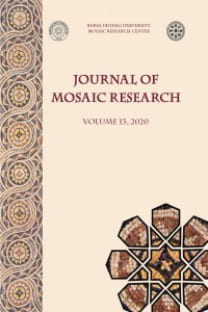Roma: İÖ 2. yüzyıl’da Ekonomik Değişim - Lüks Bir Ürün Olarak Mozaik Konteksti
Roma ekonomisi, ekonomik karmaşıklık, elit yapılar, devlet maliyesi, lüks ve mozaik
Rome: Economic Change in the 2nd Century BC - The Context of Mosaic as a Luxury Product
Roman economy second century BC, economic complexity, state finances, Infrastructures, luxury and mosaics,
___
- J. Andreau, 1987, La vie financière dans le monde romain: Les métiers de manieurs d’argent (IVe siècle av. J.-C. – IIIe siècle ap. J.-C.), Rome, École Française de Rome.
- E. Badian, 1972, Publicans and Sinners: Private Enterprise in the Service of the Roman Republic, Ithaca and London, Cornell University Press.
- P. A. Brunt, 1971, Italian Manpower: 225 BC – AD 14, Oxford, Oxford University Press.
- F. Carmo, 2010, O significado da implantação da República Romana, Masters Thesis, Universidade de Lisboa, Lisbon.
- F. Coarelli, 1977, “Public Building in Rome between the Second Punic War and Sulla”, PBSR 45, 1-23.
- F. Coarelli, 1988, “I santuari, il fiume, gli empori”, A. Momigliano - A. Schiavone (eds.), Storia di Roma, Volume primo, Roma in Italia, Torino, Giulio Einaudi editore, 127-151.
- F. Coarelli, 1990, “Roma, i Volsci e il Lazio Antico”, Crise et transformation des sociétés archaïques de l’Italie Antique au Ve siècle av. J.-C., Rome, École Française de Rome, 135-154.
- E. E. Cohen, 1992, Athenian Economy & Society: A Banking Perspective, Princeton, Princeton University Press.
- T. J. Cornell, 1995, The Beginnings of Rome: Italy and Rome from the Bronze Age to the Punic Wars (c. 1000-264 BC), London, Routledge.
- T. J. Cornell, 2000, “The City of Rome in the Middle Republic (400-100 BC)”, J. Coulston - H. Dodge (eds.), Ancient Rome: The Archaeology of the Eternal City, Oxford, University School of Archaeology.
- M. H. Crawford, 1974, Roman Republican Coinage, London, Cambridge University Press.
- J. DeLaine, 1990, “Structural Experimentation: The Lintel Arch, Corbel and Tie in Western Roman Architecture”, WorldArch, Vol. 21, No. 3, 407-24.
- J. DeLaine, 2001, “Bricks and Mortar: Exploring the Economics of Building Techniques at Rome and Ostia”, Mattingly - Salmon (eds.), Economies Beyond Agriculture in the Classical World, London and New York, Routledge, 230-68.
- K. M. D. Dunbabin, 1994, “Early pavement types in the west and the invention of the tessellation”, CMGR V, 26-40.
- K. M. D. Dunbabin, 1999a, Mosaics of the Greek and Roman World, Cambridge, Cambridge University Press.
- K. M. D. Dunbabin, 1999b, “Mosaics and their public”, M. Ennaïfer – A. Rebourg (eds.), CMGR VII, 739-45.
- M. I. Finley, 1999, The Ancient Economy, Berkeley, Los Angeles and London, University of California Press.
- T. Frank, 1933, An Economic Survey of Ancient Rome, Vol. I, Rome and Italy of the Republic, Baltimore, The Johns Hopkins Press.
- P. Green, 1997, D’Alexandre à Actium - Du partage de l’empire au triomphe de Rome, Paris, Robert Laffont.
- W. V. Harris, 1979, War and Imperialism in Republican Rome 327-70 BC, Oxford, Clarendon Press.
- K. Hopkins, 1978, Conquerors and Slaves, Cambridge, Cambridge University Press.
- P. Kay, 2014, Rome’s Economic Revolution, Oxford, Oxford University Press.
- D. Laty, 1996, Histoire des Bains, Paris, Presses Universitaires de France.
- A. Malissard, 1994, Les Romains et l’eau: fontaines, salles de bains, thermes, égouts, aqueducs…, Paris, Les Belles Lettres.
- J. W. Rich, 1983, “The Supposed Manpower Shortage of the Later Second Century BC”, Historia 32, 287-331.
- V. J. Rosivach, 2006, “The Lex Fannia Sumptuaria of 161 BC”, The Classical Journal, Vol. 102, No. 1, 1-15.
- M. I. Rostovtseff, 1988, Histoire Économique et Sociale de l’Empire Romain, Paris, Robert Laffont.
- A. Schiavone, 2002, La storia spezzata: Roma antica e Occidente moderno, Roma, Gius. Laterza & Figli.
- M. Torelli, 2007, Storia degli Etruschi, Roma-Bari, Laterza.
- Arnold Joseph Toynbee, 1965, Hannibal’s Legacy – The Hannibalic War’s Effects on Roman Life: Volume II – Rome and her Neighbours after Hannibal’s Exit, London, Oxford University Press.
- A. F. Wallace-Hadrill, 2008, Rome’s Cultural Revolution, Cambridge, Cambridge University Press.
- B. Ward-Perkins, 2005, The Fall of Rome and the End of Civilization, London, Oxford University Press.
- A. Wilson, 2006, “The Economic Impact of Technological Advances in the Roman Construction Industry”, E. Lo Cascio (ed.), Innovazione tecnica e progresso economico nel mondo romano, Bari: Edipuglia, 225-36.
- ISSN: 1309-047X
- Başlangıç: 2008
- Yayıncı: Ululdağ Üniversitesi, Mozaik Araştırlmaları Merkezi
Kırsal Kentler: Lusitania Villaları’nda Dekoratif Programlar ve Mimari Modeller
Roma Mozaiklerinin İkonografisinde Doğu Batı’ya Karşı: Ortak Konulardan Seçilmiş Örnekler
Baetica’daki Geometrik Mozaikler
Penela, Portekiz’de Yer Alan São Simão Roma Villası’ndan Mozaikler
Sónia VICENTE VICENTE, Ana Luísa MENDES
Hispanik Meseta Norte’ninMozaikleri: Evreler, Atölyeler, Sanatsal Yönü
Fernando REGUERAS, Caridad SAN JOSÉ
Portekiz’de Yer Alan São Simão Roma Villası’ndan Mozaikler
Sónia VICENTE VICENTE, Ana Luísa MENDES
Conventus Pacensis Villalarındaki Geometrik Motifler
Algarve’daki (Portekiz) Mozaikler ve Roma Resimleri Üzerindeki Figüratif Unsurlar
Batı Roma Lusitania Epigrafik Anıtlar Üzerinde Doğudan Yansımalar
Ansião Belediyesi (Portekiz), Santiago de Guarda Anıtsal Kompleksi’ndeki Roma Villası Mozaikleri
